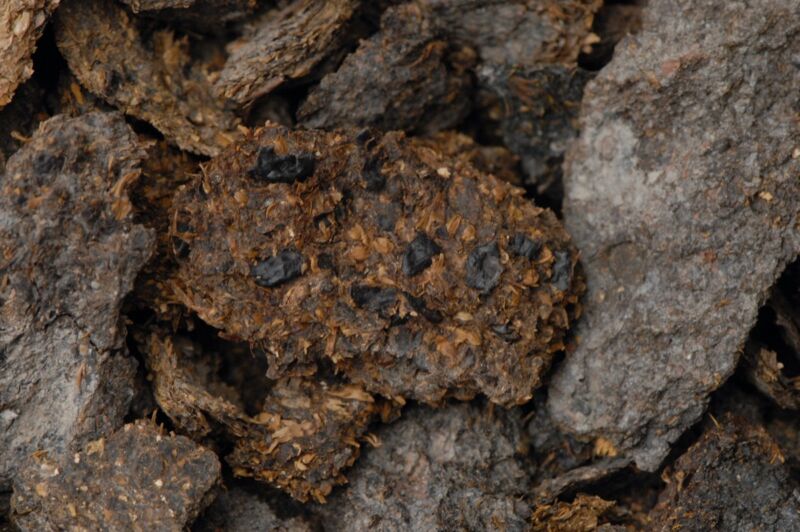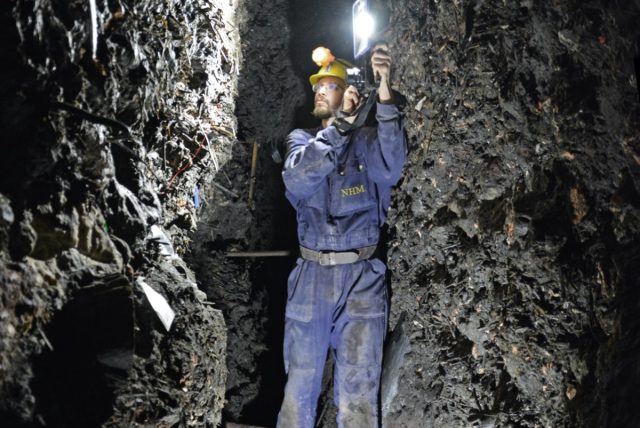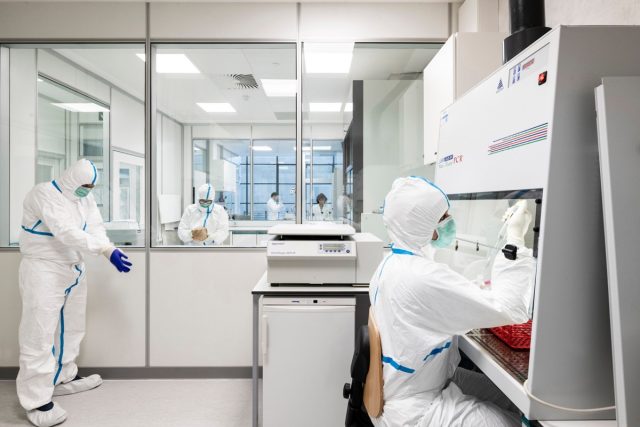Fecal matters —
They also ate primarily cereal grains, supplemented with beans, fruits, nuts, or meat.
Jennifer Ouellette
–

Enlarge / A 2,700-year-old piece of human excrement found at the Hallstatt salt mines, in which beans, millet, and barley are clearly visible (assuming one wishes to look that closely).
Ancient Iron Age miners in what is now Austria were quite fond of beer and blue cheese, according to a new analysis, published in the journal Current Biology, of preserved paleo-poop. The researchers found evidence of two fungal species commonly used to produce blue cheese and beers, along with evidence that the miners’ diet was particularly rich in carbohydrates in the form of cereal grains.
“Genome-wide analysis indicates that both fungi were involved in food fermentation and provide the first molecular evidence for blue cheese and beer consumption during Iron Age Europe,” said co-author Frank Maixner of the Eurac Research Institute for Mummy Studies in Bolzano, Italy. “The miners seem to have intentionally applied food fermentation technologies with microorganisms which are still nowadays used in the food industry.”
For archaeologists keen on learning more about the health and diet of past populations—as well as how certain parasites evolved over the evolutionary history of the microbiome—preserved samples of ancient poo can be a veritable goldmine of information. Samples are usually found in dry caves, desert areas, frozen areas, or waterlogged environments (like bogs), according to Maixner and his co-authors, where desiccation, freezing, and similar processes preserve the fecal matter for posterity.

Enlarge / Four samples of preserved human fecal matter collected from the Hallstatt salt mines.
F. Maixner/Eurac Research
As we’ve reported previously, it can be difficult to determine whether fecal samples are human or were produced by other animals, particularly dogs. Usually, only those samples found with human skeletons or mummies could be designated as being of human origin with any certainty. That’s why scientists developed a tool last year (dubbed coproID) capable of determining whether paleofeces and coprolites recovered from archaeological sites are of human or animal origin. Among other discoveries, the researchers found that the archaeological record was unexpectedly “full of dog poop.”
One excellent source of human paleofeces samples is the prehistoric underground salt mines of Hallstatt-Dachstein/Salzkammergut, a UNESCO World Heritage site in Austria. The mines have high salt concentrations and a constant annual temperature of around 8 degrees Celsius, which is ideal for preserving organic materials like feces. Archaeologists have unearthed thousands of Bronze and Iron Age tools and implements made from wood and fur, as well as rawhide, woolen textile fragments, ropes—and yes, human feces, typically recovered by wet-sieving larger blocks of debris found in the mines. These artifacts have provided insight into the daily life of the miners.
The present study focused on investigating the miners’ dietary habits, as revealed by the analysis of gut microbes present in the preserved poop. Maixner et al. examined four paleofecal samples. Radiocarbon dating revealed that one was from the Late Bronze Age, two were from the Iron Age, and one dated to the 18th century AD—most likely because the mines began to be re-used around that time. The researchers were able to retrieve DNA and proteins from all four samples and determined that all four came from men. “The DNA damage is exceptionally low,” the authors noted in their paper. “This high preservation is most likely due to the rapid desiccation of the samples in the salt mine.”

Enlarge / An intrepid archaeologist standing in the middle of layers of mining debris—including paleofeces.
D. Brander/H. Reschreiter/NHMW
The molecular and microscopic analysis showed that the miners primarily subsisted on cereals like emmer, spelt, barley, and millet—a diet rich in carbohydrates and supplemented with beans, fruits, seeds, nuts (walnut), or meats (cattle and swine). The Bronze Age sample showed almost exclusively cereal grain remains, along with a few weeds like corn cockle and poison parsley. The Iron Age samples were similar, except one sample had remains of broad beans, crabapples, and cranberries.
The 18th-century sample was notably different. The cereal remains (wheat and barley bran) were much more finely textured—evidence of grinding—with some garden beans and almost no fruits. “This suggest that the protohistoric miners consumed the cereals and legumes in a sort of gruel or porridge, whereas miners in the 18th century ate their cereals in a more processed form, e.g., as a bread or biscuit,” the authors wrote. The team also found evidence that the men who produced the Iron Age and 18th-century fecal samples suffered from intestinal infections (whipworm and roundworm).
The microbiomes of all four samples were quite similar to the gut microbiomes of non-Westernized populations today, particularly in the abundance of Prevotella copra, which is associated with the digestion of complex carbohydrates, according to the authors. This “adds weight to the hypothesis that the modern industrialized human gut microbiome has diverged from an ancestral state, probably due to modern lifestyle, diet, or medical advances,” they wrote. Analyzing fecal samples from the last two to three centuries would help pinpoint when that pivotal shift occurred.

Enlarge / Scientists analyzing paleofeces in the laboratory at Eurac’s Institute for Mummy Studies.
Ivo Corra/Eurac Research
All the samples showed some evidence of fungal DNA, but the Iron Age sample also had a high abundance of two species of fungi: Penicillium roqueforti—commonly used in the fermentation of cheese—and Saccharomyces cerevisiae, used for fermenting bread and alcoholic beverages like beer, mead, and wine. The former would have likely produced a cheese similar to modern blue cheese, indicating “a major step in ruminant milk processing from fresh to ripened cheese,” the authors wrote—perhaps because the ripened cheese would have lower lactose content and could be stored for longer periods.
As for the S. cerevisiae, the researchers were able to reconstruct about 90 percent of the fungal genome from the paleo-poop sample and concluded that it was most likely used to ferment beer. With the many fermentable cereals that constituted the subject’s diet, the researchers were even able to hypothesize about the likely process. The miners could have simply added water to wort and allowed fermentation to happen naturally via wild, airborne yeasts. But they didn’t find evidence of other yeast species common to this kind of natural fermentation process.
Rather, they found evidence of domestication of yeasts, either through the reuse of vessels or through the practice of “back-slopping,” in which new batches are inoculated with portions from previous batches. The team concluded that the miners were brewing the modern equivalent of pale beer, “produced mainly by top-fermenting S. cerevisiae strains,” they wrote.
“These results shed substantial new light on the life of the prehistoric salt miners in Hallstatt and allow an understanding of ancient culinary practices in general on a whole new level,” said co-author Kerstin Kowarik of the Museum of Natural History Vienna. “It is becoming increasingly clear that not only were prehistoric culinary practices sophisticated but also that complex processed foodstuffs as well as the technique of fermentation have held a prominent role in our early food history.”
DOI: Current Biology, 2021. 10.1016/j.cub.2021.09.031 (About DOIs).

